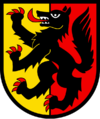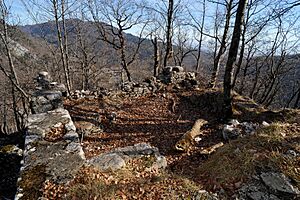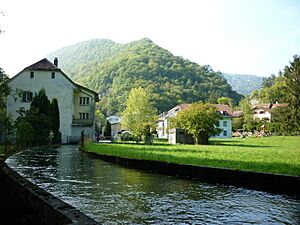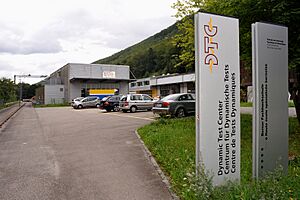Vauffelin facts for kids
Quick facts for kids
Vauffelin
|
||
|---|---|---|

Frinvillier village main street
|
||
|
||
| Country | Switzerland | |
| Canton | Bern | |
| District | Jura bernois | |
| Area | ||
| • Total | 5.92 km2 (2.29 sq mi) | |
| Elevation | 707 m (2,320 ft) | |
| Population
(Dec 2011)
|
||
| • Total | 427 | |
| • Density | 72.13/km2 (186.8/sq mi) | |
| Postal code |
2537
|
|
| Surrounded by | Orvin, Péry, Plagne, Romont, Pieterlen, Biel/Bienne | |
Vauffelin is a former town in the canton of Bern in Switzerland. It is located in the French-speaking area called the Bernese Jura. On January 1, 2014, Vauffelin and another town, Plagne, joined together. They are now part of a new town called Sauge.
Contents
History of Vauffelin
Vauffelin was first mentioned in old records in 1228. It was once known by its German names, Füglistal or Füglisthal, but these names are not used anymore. The nearby village of Frinvillier was first mentioned in 1393.
Frinvillier was an important spot in Roman times. Two major Roman roads met there. One road went from Petinesca (now Studen) over the Pierre Pertuis pass. It led to Augusta Raurica, a Roman city. The other road went from Eburodunum (now Yverdon) to Salodurum (Solothurn). A watch tower was built at Rondchâtel to protect these roads.
In 1364, the Count Thierstein gave the church in Vauffelin to the Church of St. Benedict in Biel. For many years, Vauffelin was part of a larger area called the seigniory of Erguel. This area was ruled by the Prince-Bishop of Basel.
After France won a war in 1797, Vauffelin became part of a French region called Mont-Terrible. Later, in 1800, it became part of another French region, Haut-Rhin. After Napoleon was defeated, Vauffelin became part of the Canton of Bern in 1815.
Vauffelin became Protestant in 1530 when Biel adopted the new faith. At first, a pastor from Orvin helped the church in Vauffelin. After 1798, a pastor from Péry took over this job. In 1839, Vauffelin got its own church area, or parish, with Romont. The church was built in 1715-16 and fixed up several times. In 2010, Vauffelin joined the parish of Rondchâtel with Péry-La Heutte and Orvin.
In the 1970s, more people moved to Vauffelin. These were people who worked in Biel and traveled to work each day. In 1971, Vauffelin, Romont, and Frinvillier created a shared school district.
Geography of Vauffelin
Before it merged, Vauffelin covered about 6 square kilometers (2.3 square miles). A large part of this land, about 35.7%, was used for farming. More than half, about 56.9%, was covered by forests. About 7.2% of the land had buildings or roads.
Most of the forest land, 52.3%, was heavily wooded. About 4.5% had orchards or small groups of trees. For farming, 5.9% was used for growing crops. Another 19.5% was used for pastures where animals graze.
Vauffelin is located in the Bernese Jura region. It includes the villages of Vauffelin and Frinvillier. On January 1, 2010, Vauffelin became part of the new Jura bernois administrative district.
Vauffelin's Coat of Arms
The coat of arms for Vauffelin shows a black wolf on a background of gold and red.
Population and People
In 2011, Vauffelin had 427 people living there. In 2010, about 18% of the people were foreign nationals. Over ten years, the population changed a little, decreasing by 0.9%.
Most people in Vauffelin speak French as their main language. In 2000, about 64.9% spoke French. German was the second most common language, spoken by 24.7% of the people. Albanian was third, spoken by 7.4%.
In 2008, about 51.8% of the people were male and 48.2% were female. About 26.1% of the people living in Vauffelin in 2000 were born there. Many others were born in the same canton or elsewhere in Switzerland. About 21.8% were born outside Switzerland.
In 2010, children and teenagers (0–19 years old) made up 21.5% of the population. Adults (20–64 years old) made up 59.6%. Older people (over 64 years old) made up 18.9%.
In 2000, there were 50 households with only one person. There were 14 households with five or more people. Most apartments were lived in all the time.
The chart below shows how the population of Vauffelin has changed over the years:

Places to See
The beautiful Taubenlochschlucht, or Taubenloch Canyon, is a special place. It is shared by Vauffelin and nearby towns like Biel/Bienne, Orvin, and Péry. This canyon is part of the Inventory of Swiss Heritage Sites. This means it is a very important place for Switzerland's history and nature.
Economy and Jobs
In 2011, Vauffelin had a low unemployment rate of 2.79%. In 2008, 81 people worked in the town.
- 12 people worked in the primary sector. This means they worked in farming or forestry.
- 17 people worked in the secondary sector. This means they worked in factories or construction.
- 52 people worked in the tertiary sector. This means they worked in services, like shops or offices.
Many people who lived in Vauffelin worked outside the town. In 2000, 173 people traveled away from Vauffelin for work. Only 38 people traveled into Vauffelin for work. This means more people left the town for jobs than came in. About 19.9% of workers used public transportation. Most, 63.4%, used a private car to get to work.
Religion in Vauffelin
Based on the 2000 census:
- About 18.2% of the people were Roman Catholic.
- About 51.2% belonged to the Swiss Reformed Church (a Protestant church).
- About 5.39% belonged to other Christian churches.
- About 10.34% were Islamic.
- About 12.58% did not belong to any church. Some were agnostic (not sure about God) or atheist (do not believe in God).
Education in Vauffelin
In Vauffelin, about 36.4% of adults have finished high school. About 9.2% have gone on to higher education, like a university or a specialized college (Fachhochschule).
The school system in the Canton of Bern works like this:
- One year of optional kindergarten.
- Six years of primary school.
- Three years of required lower secondary school. Students are grouped by their skills.
After lower secondary school, students can continue their education. They can also start an apprenticeship, where they learn a job skill.
During the 2010-11 school year, 18 students attended classes in Vauffelin. There were no kindergarten classes. All students went to one primary school class. Some of these students were not Swiss citizens. Some also spoke a different language at home than the one used in class.
In 2000, 5 students from other towns came to school in Vauffelin. However, 56 students from Vauffelin went to schools outside the town.
See also
 In Spanish: Vauffelin para niños
In Spanish: Vauffelin para niños









